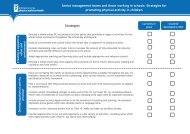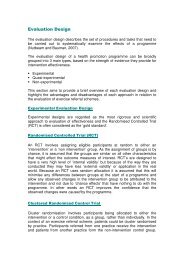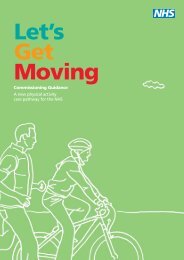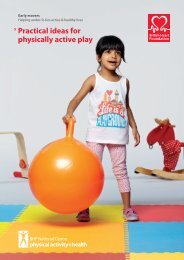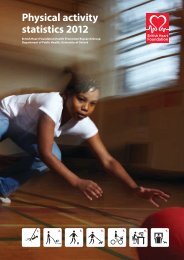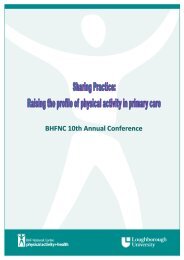Working papers - BHF National Centre - physical activity + health
Working papers - BHF National Centre - physical activity + health
Working papers - BHF National Centre - physical activity + health
Create successful ePaper yourself
Turn your PDF publications into a flip-book with our unique Google optimized e-Paper software.
programme evaluation CONTINUED<br />
Qualitative methods<br />
Type Description Applications Strengths Limitations<br />
Focus groups<br />
Semi-structured<br />
discussion (8-12<br />
people)<br />
Lead by facilitator who<br />
follows an outline<br />
and manages group<br />
dynamics<br />
Proceedings are<br />
recorded<br />
To gather in-depth<br />
information from<br />
small number of<br />
stakeholders<br />
Pre-test materials with<br />
target audience<br />
To develop better<br />
understanding of<br />
attitudes, opinions and<br />
language<br />
Often used to prepare<br />
larger survey<br />
Provides in-depth<br />
information<br />
Implementation and<br />
analysis requires<br />
minimum of<br />
specialised skills<br />
Can be inexpensive to<br />
implement<br />
Participants may<br />
influence each other<br />
Subjective<br />
Potential for factor bias<br />
Can be difficult to<br />
analyse<br />
Results are not<br />
quantifiable to a<br />
population<br />
In-depth interviews<br />
Telephone or inperson<br />
one-to-one<br />
interviews<br />
Interviewer follows<br />
an outline but has<br />
flexibility<br />
Usually 10 -40 per<br />
type of respondent<br />
To investigate sensitive<br />
issues with small<br />
numbers of people<br />
To develop better<br />
understanding of<br />
attitudes, opinions and<br />
language<br />
Provides a confidential<br />
environment<br />
Eliminates peer<br />
influence<br />
Opportunity to explore<br />
unexpected issues<br />
More detailed<br />
information than focus<br />
group<br />
More expensive<br />
to implement and<br />
analyse than focus<br />
groups<br />
Potential for<br />
interviewer bias<br />
Can be difficult to<br />
analyse<br />
Results are not usually<br />
quantifiable to the<br />
population<br />
Open ended survey<br />
questions<br />
Structure questions<br />
on a telephone or<br />
mail survey that allow<br />
respondent to provide<br />
a complete answer in<br />
their own words<br />
To add depth to<br />
survey results<br />
To further explore the<br />
reasons for answers to<br />
closed questions<br />
For exploratory<br />
questions<br />
Can provide depth<br />
with the potential to<br />
be quantified<br />
Adds depth to<br />
qualitative data<br />
Generalisable to the<br />
population<br />
Time consuming to<br />
analyse properly<br />
Adds considerable<br />
time to survey<br />
Not flexible<br />
Diaries<br />
Detailed account<br />
of aspects of your<br />
programme<br />
Ongoing<br />
documentation by one<br />
or more of participants<br />
Used primarily for<br />
process evaluation<br />
Puts other evaluation<br />
results in context<br />
Captures information<br />
you may not have<br />
thought of<br />
Very inexpensive to<br />
collect<br />
Can be difficult or<br />
expensive to analyse<br />
Observations are<br />
subjective<br />
Source: The Health Communication Unit at the <strong>Centre</strong> for Health Promotion, University of Toronto.<br />
www.utoronto.ca/chp/hcu/<br />
Section 4 Active for later life | 53



